Table of Contents
- Introduction
- Editor’s Choice
- General Eating Disorders Statistics
- Prevalence of Bulimia and Related Disorders in North America
- Prevalence of Bulimia and Related Disorders in Asia-Pacific
- Prevalence of Bulimia and Related Disorders in Europe
- Age-related Dynamics of Patients Who Have Bulimia and Related Disorders
- Gender-related Dynamics of Patients Who Have Bulimia and Related Disorders
- Ethnicity-related Dynamics of Patients Who Have Bulimia and Related Disorders
- Bulimia and Related Disorders Treatment Facilities
- Key Funding and Investment Trends
- Costs Associated with Bulimia and Related Eating Disorders
- Programs and Initiatives to Combat Bulimia
- Regulations for Bulimia Treatment
- Recent Developments
- Conclusion
- FAQs
Introduction
Bulimic Statistics: Bulimia nervosa is an eating disorder characterized by cycles of binge eating followed by compensatory behaviors, such as vomiting, excessive exercise, or laxative use, to prevent weight gain.
It is often associated with psychological factors like low self-esteem, anxiety, and depression. The disorder can lead to serious health risks, including electrolyte imbalances, gastrointestinal issues, and cardiovascular complications.
Effective treatment typically involves a combination of psychotherapy, nutritional counseling, and medical management.
While more common among young women, bulimia can affect individuals of any gender and age. Highlighting the importance of early intervention for improved outcomes.

Editor’s Choice
- The number of cases of anorexia nervosa or bulimia in Spain reached 83,734 in 2021.
- In England during the 2022/23 period, the number of hospital admissions due to bulimia nervosa varied across different age groups. The highest number of diagnoses was observed in the 30 to 34 age group, with 1,085 admissions. Closely followed by the 25 to 29 age group, with 1,081 admissions.
- From 2014 to 2019, Mexico saw a notable increase in the rate of new cases of anorexia and bulimia. With distinct differences observed between genders. In 2014, the rate of new cases among women was 2.08 per 100,000 population. Which gradually increased each year, reaching 3.5 by 2019.
- In 2013, the time taken for individuals in the United Kingdom to seek help for bulimia nervosa varied widely. Reflecting significant delays in addressing this eating disorder. The most substantial delay was observed in those who waited more than 12 months to seek assistance, comprising 54.10% of the respondents.
- The market size for virtual eating disorder treatment is projected to reach $2,072.0 million by 2033.
- Between 2018 and 2019, the average health system costs per person. Treating various eating disorders in the United States varied significantly based on the type of disorder. Bulimia nervosa followed with a considerably lower cost of $1,335 per person. Indicating potentially less complex or shorter treatment protocols.
- The U.S. policy has historically focused more on educational and treatment initiatives rather than direct regulation. The 21st Century Cures Act is a notable federal initiative. Incorporating key aspects of the Anna Westin Act to enhance health insurance coverage and increase educational resources about eating disorders.

General Eating Disorders Statistics
Share of the Population with an Eating Disorder Worldwide
- The data indicates a stable prevalence of eating disorders globally, maintaining a rate of 0.16% from 1990 through 2007.
- A slight increase was observed beginning in 2008, with the percentage rising to 0.17%, where it remained steady until 2014.
- From 2015 onwards, there was another gradual increase, with the prevalence reaching 0.18%, a level it maintained through 2019.
- This trend suggests a gradual but steady rise in the percentage of the population suffering from eating disorders over the three decades covered by the data.
(Source: Statista)
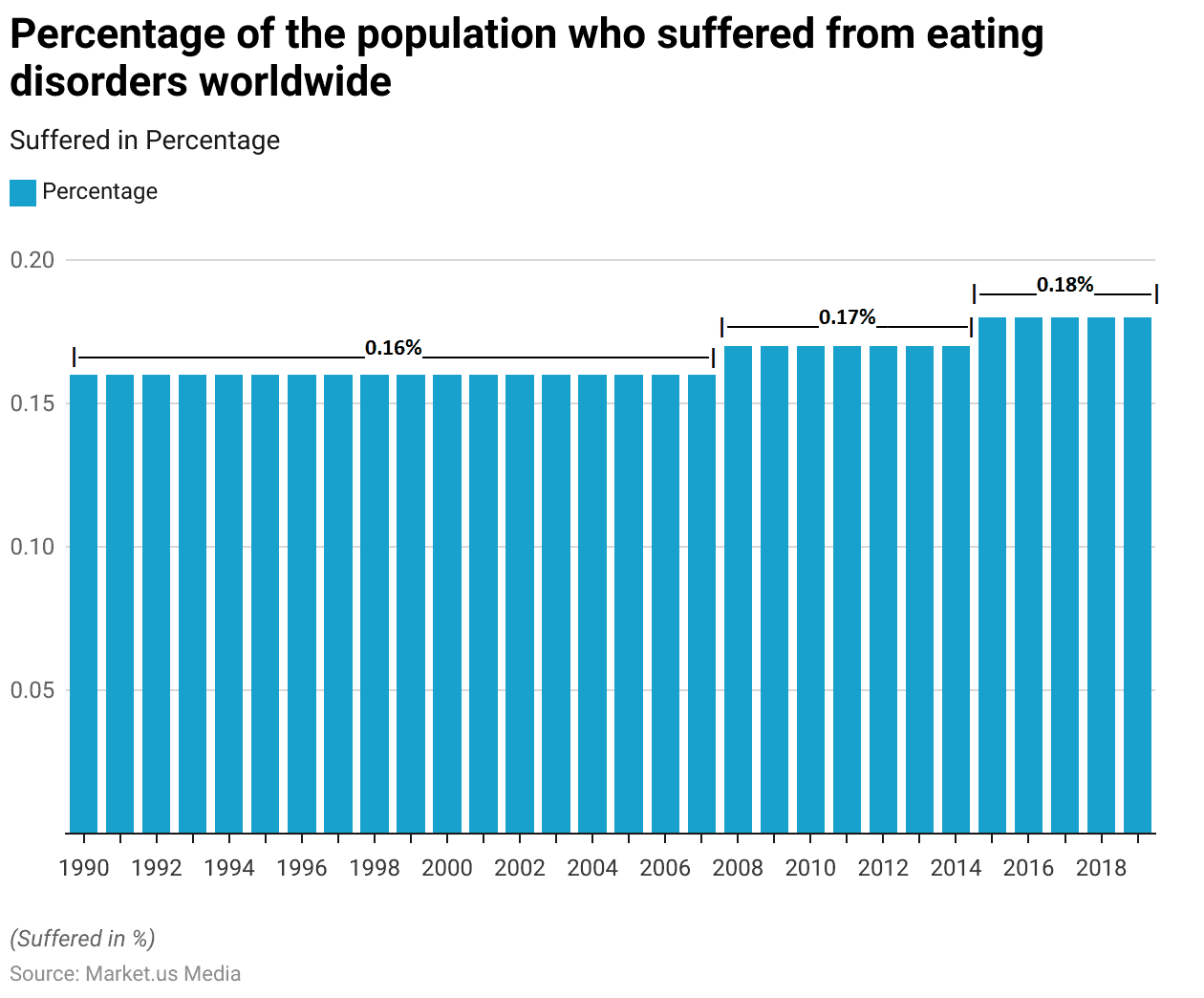
Deaths from Eating Disorders Worldwide
- The number of direct deaths attributed to eating disorders worldwide has shown a gradual increase over three decades from 1990 to 2019.
- In 1990, there were 178 reported deaths, and this number gradually rose over the following years.
- By 1991, the count increased to 184 and continued to rise, reaching 193 by 1992.
- A noticeable uptick continued through the mid-1990s, With 218 deaths in 1994 and further rising to 227 in 1995.
- The trend persisted into the late 1990s and early 2000s, With the number reaching 243 in 1997 and slightly plateauing around 262 by the mid-2000s.
- However, a gradual increase resumed from 2007 onward, culminating in 270 deaths that year.
- This growth trend continued, albeit slowly, through the next decade. With the number reaching 276 in 2008 and further increasing to 318 by 2019.
- The data underscores a consistent, albeit moderate, rise in mortality due to eating disorders over the period studied.
(Source: Statista)
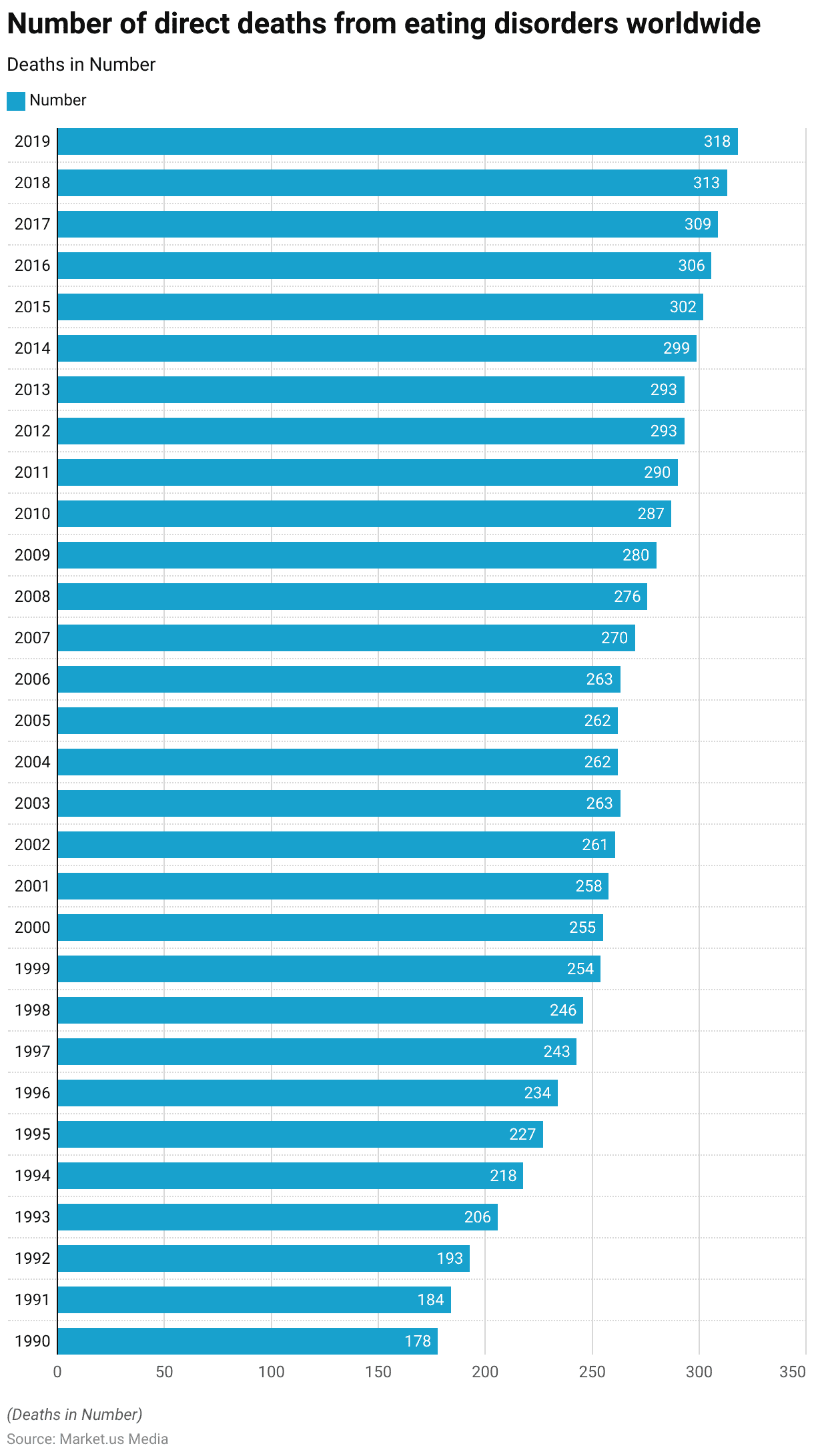
Prevalence of Bulimia and Related Disorders in North America
United States
Share of the U.S. Population with an Eating Disorder
- The prevalence of eating disorders among the U.S. population saw a gradual increase from 1990 to 2003 and then exhibited a slight decline in subsequent years.
- Starting at 0.43% in 1990, the percentage slowly rose. Reaching 0.45% in 1991 and continuing to incrementally increase each year until it peaked at 0.50% in 2003. A level that it maintained through 2011.
- After this period, a gradual decrease in prevalence was observed.
- By 2012, the rate had slightly reduced to 0.49%, and it continued to decline over the next several years. Reaching a lower level of 0.46% by 2014 and maintaining that rate through 2019.
- This data reflects a long-term trend of initially rising and then slightly decreasing the prevalence of eating disorders within the U.S. over the three decades.
(Source: Statista)
Take advantage of our unbeatable offer - buy now!

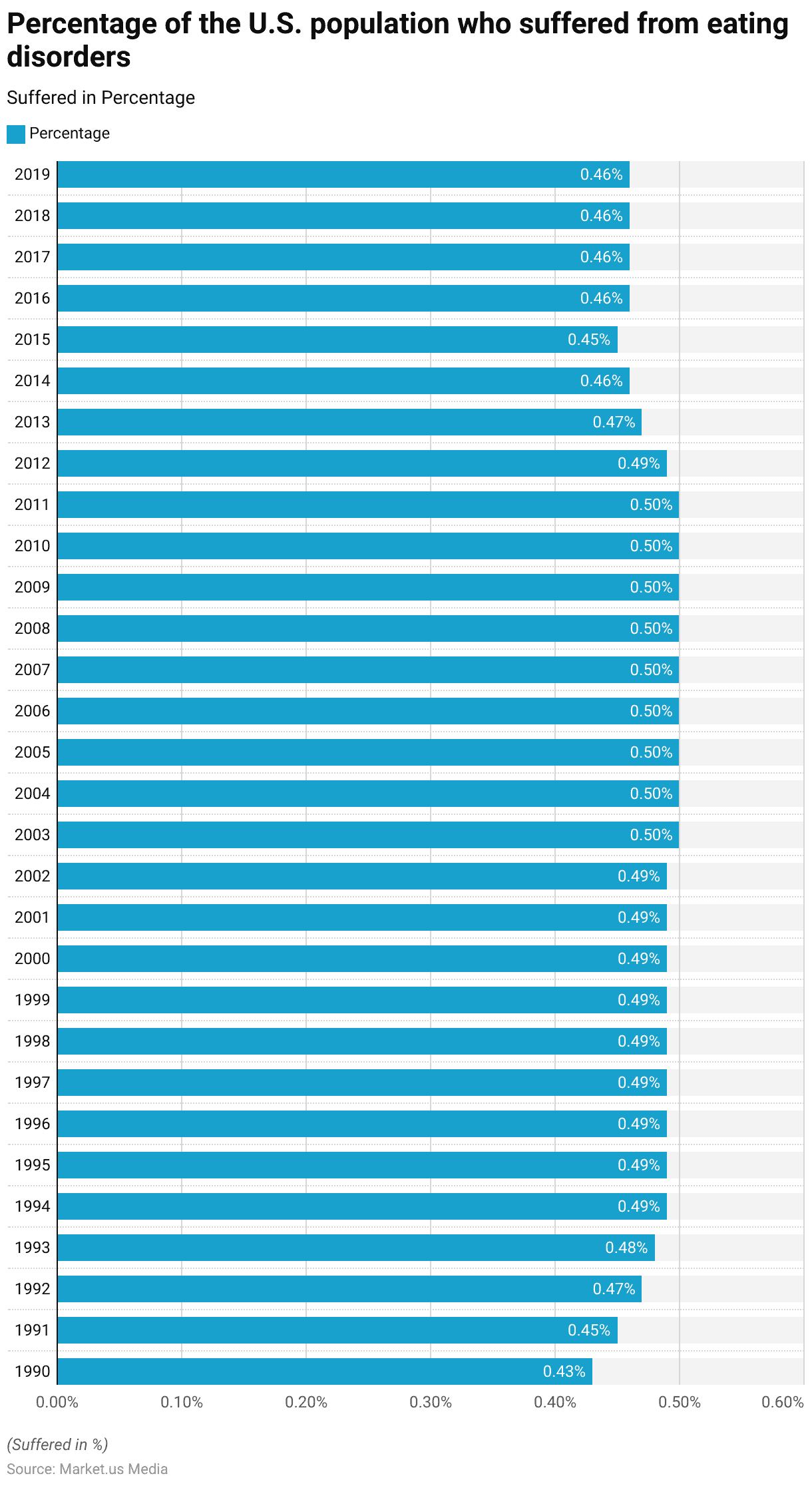
Bulimia Diagnosis in the U.S.
- In the fall of 2018, the majority of U.S. college students reported not having been diagnosed with bulimia or anorexia. With 98.70% and 98.30%, respectively, indicating no diagnosis of these conditions.
- Among those diagnosed, 0.60% had received a diagnosis for either condition but had not been treated.
- Treatment modalities varied: 0.20% of students were treated with medication alone for both bulimia and anorexia. Psychotherapy was utilized by 0.30% for bulimia and 0.50% for anorexia. A combination of medication and psychotherapy was used by 0.20% for bulimia and 0.30% for anorexia.
- Other forms of treatment were reported by 0.10% of students for bulimia and 0.20% for anorexia.
- These statistics highlight the relatively low but significant engagement of U.S. college students with treatment modalities for these serious health conditions.
(Source: Statista)
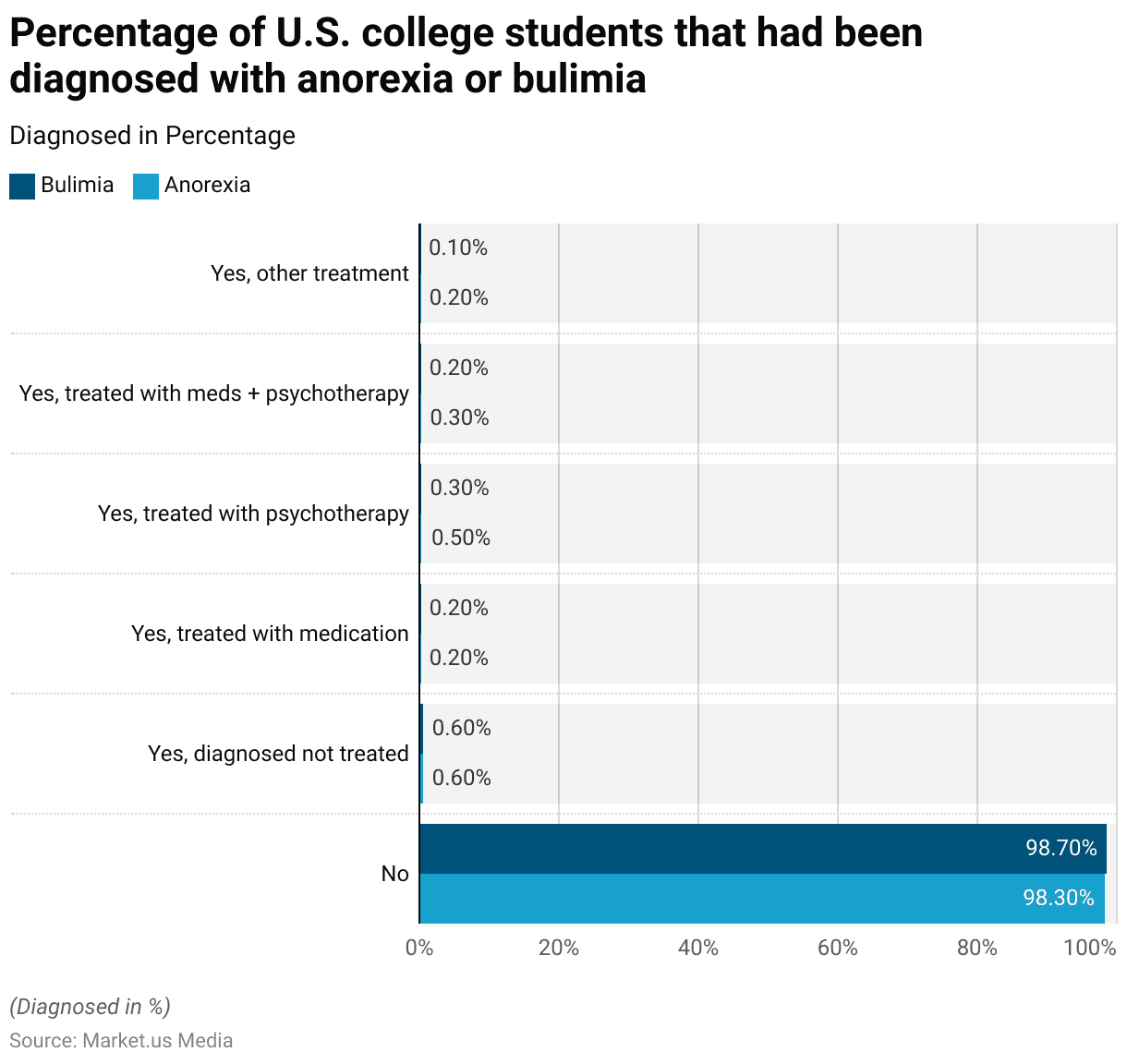
Canada
- Research shows that the prevalence rates for eating disorders range from 2% to 3%. According to 2016 data from Statistics Canada. It is estimated that between 725,800 and 1,088,700 Canadians qualify for an eating disorder diagnosis.
- A community-based study in Ontario, which examined 8,116 individuals aged 15 to 65 years across 42 health units. Found that the lifetime prevalence of bulimia nervosa (B.N.) was 1.1% among females. Which increased to 1.22% when including those who did not meet the frequency criterion. For males, the rate was 0.1%, increasing to 0.38% under the same conditions.
- For anorexia nervosa (AN), 2.0% of female respondents met the criteria for either full or partial-syndrome AN. With 0.56% having full-syndrome AN and 1.4% having partial-syndrome AN. Within this partial-syndrome group, 1.0% only lacked the amenorrhea criterion.
- Another Ontario study involving 9,953 participants aged 15-65 from a community epidemiologic survey supplemented by the Ontario health survey revealed that the lifetime prevalence of AN was 0.16% for both males and females. At the same time, for B.N., it was 0.13% for males and 1.46% for females.
- The prevalence for any full or partial eating disorder was 2.0% for males and 4.8% for females. With full-syndrome eating disorders affecting 0.3% of men and 2.1% of women.
- A study from Quebec, which surveyed 1,310 women aged 20-40 years via telephone from November 2002 to May 2003. Indicated that the point prevalence for B.N. was 0.2% for the purging subtype and 0.4% for the non-purge subtype, totaling 0.6% for B.N. overall.
- Additionally, 4.1% of participants reported clinically significant levels of binge eating.
(Source: National Initiative for Eating Disorders)
Prevalence of Bulimia and Related Disorders in Asia-Pacific
India
- In 2017, the burden of eating disorders in India, measured in disability-adjusted life years (DALYs) per 100,000 inhabitants, varied significantly across different states.
- Goa reported the highest DALYs at 54, closely followed by Sikkim and Delhi, each with 52.
- Other Union Territories, excluding Delhi, had a DALY rate of 48.
- Maharashtra, Haryana, and Telangana each recorded a DALY of 43, while Uttarakhand reported 42.
- Both Tamil Nadu and Gujarat, along with Himachal Pradesh, noted a DALY rate of 41.
- Punjab, Arunachal Pradesh, and Karnataka each had a DALY of 40, slightly higher than Nagaland’s 39.
- Mizoram, Andhra Pradesh, and Kerala each had 38 DALYs.
- West Bengal reported 37, and Tripura, Meghalaya, and Jammu and Kashmir each had 36.
- Chhattisgarh had a rate of 35, whereas Rajasthan and Odisha each reported 34.
- Jharkhand, Manipur, and Assam each had 33 DALYs, followed by Madhya Pradesh at 32.
- Uttar Pradesh had a slightly lower rate of 30, with Bihar recording the lowest DALYs at 26 per 100,000 inhabitants. Reflecting a varied regional distribution of the health impact of eating disorders across the country.
(Source: Statista)
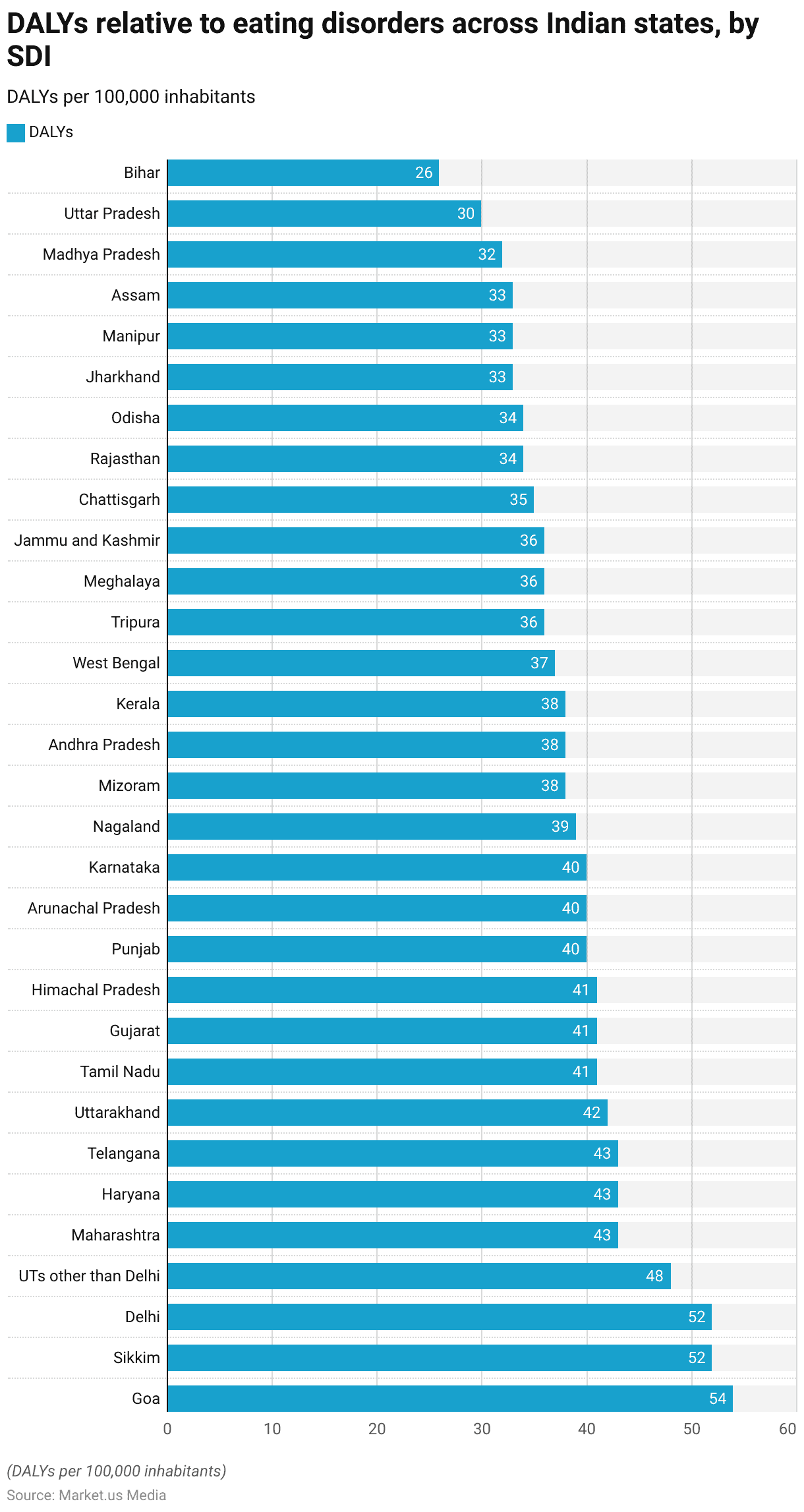
China
1990-2001
- From 1990 to 2001, the number of people with eating disorders in China exhibited a steady increase. In 1990, there were approximately 918.99 thousand individuals diagnosed with eating disorders.
- This number gradually rose over the years, reaching 929.46 thousand in 1991 and continuing to increase to 941.20 thousand in 1992. By 1993, the number had risen to 952.75 thousand.
- This upward trend persisted throughout the decade. With the figures reaching 963.40 thousand in 1994 and steadily climbing each year to 1,008.71 thousand by 1997.
- The growth continued into the 2000s, when the number of affected individuals surpassed one million for the first time in 1998, recording 1,029.91 thousand cases and further increasing to 1,049.16 thousand in 1999.
- By the year 2000, the figure stood at 1,070.97 thousand and continued to rise, reaching 1,095.30 thousand in 2001.
2002-2019
- The numbers kept growing, hitting 1,122.34 thousand in 2002, 1,149.68 thousand in 2003, and 1,176.38 thousand in 2004. This trend of increase was sustained, with the population diagnosed with eating disorders reaching 1,203.15 thousand in 2005 and 1,227.03 thousand in 2006.
- By 2007, the number had increased to 1,253.76 thousand. Continuing to rise each subsequent year to 1,278.36 thousand in 2008 and 1,303.92 thousand in 2009. The 2010s saw a continuation of this pattern. With 1,327.69 thousand cases recorded in 2010 and a gradual increase to 1,348.28 thousand in 2011.
- The number climbed to 1,366.39 thousand in 2012, 1,384.56 thousand in 2013, and slightly higher to 1,404.20 thousand in 2014. The figure then increased more sharply to 1,425.64 thousand in 2015 and 1,467.09 thousand in 2016.
- The number peaked in 2018 at 1,501.71 thousand before slightly declining to 1,495.46 thousand in 2019. Over the three decades, China saw a persistent rise in the incidence of eating disorders among its population.
(Source: Statista)
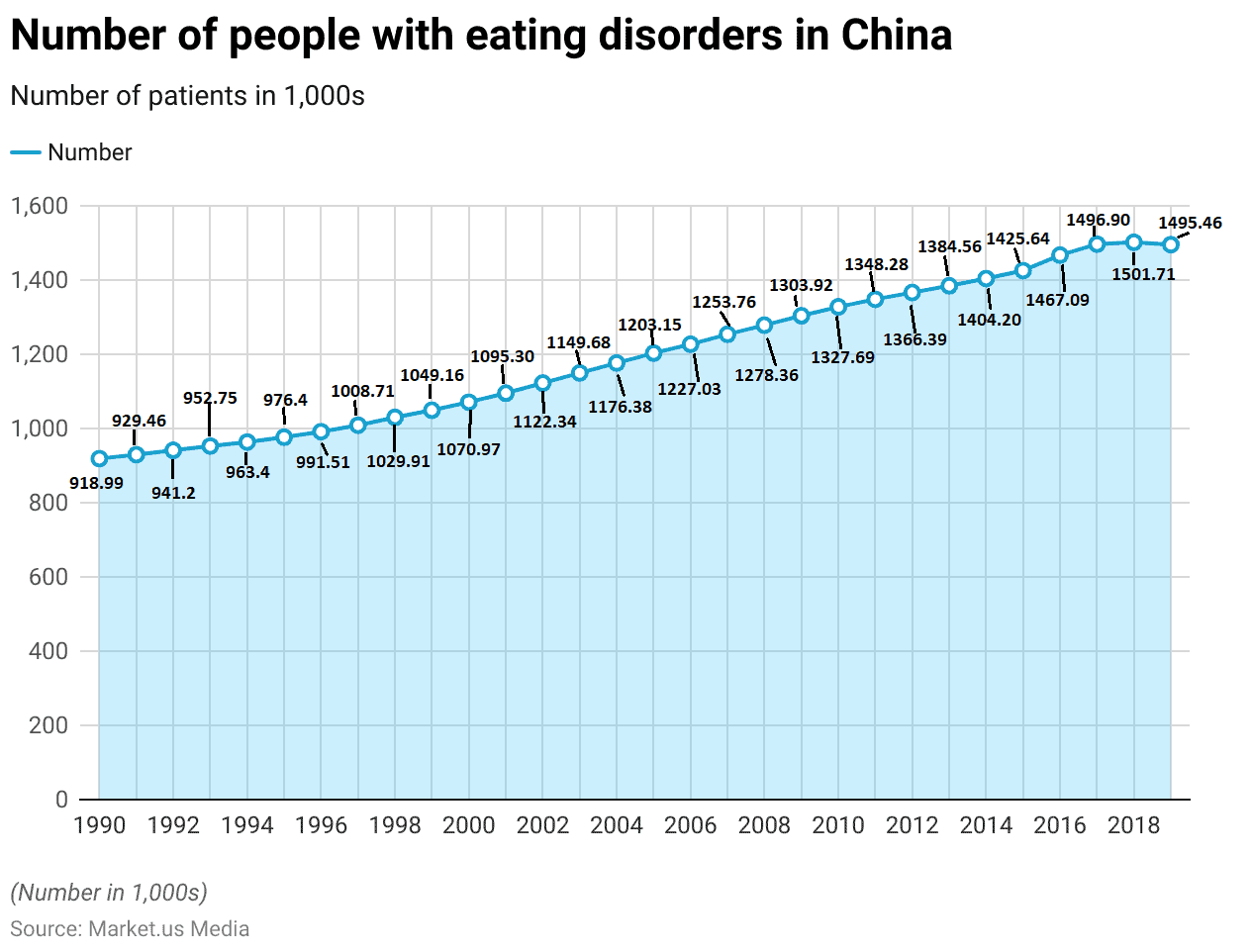
Australia
- In any given year, about one million Australians, or 4% of the population, are affected by an eating disorder.
- A significant portion of the population, particularly adolescents, exhibits disordered eating behaviors. Such as extreme dieting, binge eating, vomiting, and the use of laxatives. These do not necessarily qualify as full-fledged eating disorders.
- Specifically, about 31.6% of Australian teenagers engage in these problematic eating behaviors annually.
- Symptoms of eating disorders have been increasingly prevalent, with the frequency of weekly binge eating episodes. Rising nearly six times and strict dieting nearly quadrupled since the late 1990s.
- This rise is accompanied by other related symptoms, including more frequent dieting and a decline in quality of life.
- Among those diagnosed with eating disorders, the distribution includes 3% with anorexia nervosa, 12% with bulimia nervosa, 47% with binge eating disorder (BED), and 38% with other types of eating disorders.
(Source: National Eating Disorders Collaboration)
Japan
- According to national epidemiological research conducted in 1998 across 23,401 medical facilities in Japan, the estimated prevalence of anorexia nervosa was between 0.083% to 0.119%, and bulimia nervosa between 0.043% to 0.059%.
- The number of patients with anorexia nervosa had increased fourfold, suggesting underreporting as not all patients seek medical help.
- Eating disorders typically begin between ages 10 and 19, with anorexia nervosa commonly starting in the teenage years and bulimia nervosa in the twenties.
- Recent trends show a decrease in the onset age of eating disorders. Predominantly, 90% of those affected are females.
- Research in metropolitan areas in 2011 noted a sharp increase in suspected eating disorders among eighth graders, peaking in tenth to twelfth graders.
(Source: Tokyo University of Agriculture Repository)
Malaysia
- Research among university students in Malaysia indicates that about 20% are at risk of developing an eating disorder.
- However, disclosure and treatment rates remain low, with only approximately 6% of individuals with bulimia and 30% with anorexia seeking treatment.
- The annual loss of healthy life years per 100,000 people due to anorexia nervosa in Malaysia has risen by 7.3% since 1990, averaging an increase of 0.3% per year.
- The lifetime prevalence of bulimia is estimated at 1.0%.
- Additionally, between 1.1% and 4.6% of females and 0.1% to 0.5% of males may develop bulimia.
(Source: Relate Malaysia)
Prevalence of Bulimia and Related Disorders in Europe
Spain
- The number of cases of anorexia nervosa or bulimia in Spain saw a significant increase from 2011 to 2021.
- In 2011, there were 14,659 recorded cases, which increased to 22,259 by 2012 and continued to rise steadily to 30,272 in 2013.
- The number of cases reached 32,503 in 2014 and further increased to 36,258 in 2015.
- A notable jump occurred in 2016 when cases rose sharply to 60,189.
- The trend continued, with the numbers slightly increasing to 62,508 in 2017, then slightly declining to 61,438 in 2018.
- However, there was a surge again in 2019 with 77,590 cases, followed by further increases to 79,151 in 2020 and reaching 83,734 in 2021.
- This decade-long trend highlights a consistent and concerning rise in the prevalence of these eating disorders in Spain.
(Source: Statista)

Italy
- From 2010 to 2017, the prevalence rate of bulimia nervosa among females in Italy showed a steady decline.
- Starting at 580.6 cases per 100,000 population in 2010, the rate gradually decreased each year.
- In 2011, the prevalence was recorded at 575.07, and it continued to drop to 569.63 in 2012.
- The downward trend persisted through the following years, with the prevalence reaching 564.48 in 2013, 559.46 in 2014, and 554.42 in 2015.
- By 2016, the rate had further reduced to 550.42, finally falling to 546.9 by 2017.
- This indicates a consistent decrease in the occurrence of bulimia nervosa among females in Italy over the eight years.
(Source: Statista)

Germany
- Between the years 2000 and 2022, the number of diagnosed cases of anorexia and bulimia in German hospitals exhibited distinct trends.
- Starting in 2000, there were 5,363 cases of anorexia and 2,726 cases of bulimia.
- Over the next few years, the number of anorexia cases gradually increased, reaching a peak of 9,775 cases in 2022.
- The progression was not linear, however; a notable jump in anorexia diagnoses occurred in 2021, rising sharply from 7,355 cases in 2020 to 9,622 cases.
- In contrast, the trend in bulimia diagnoses followed a different pattern. Initially, the cases rose from 2,726 in 2000 to a peak of 3,145 in 2002 but then began a general decline.
- By 2022, bulimia cases had decreased to 1,428, marking a significant reduction over the two decades.
- The sharpest decline in bulimia diagnoses was observed from 2019 to 2020, where cases dropped from 1,677 to 1,403.
- These data points suggest a rising concern with anorexia in recent years. In contrast, bulimia diagnoses have shown a decreasing trend, highlighting potentially shifting patterns in eating disorder presentations or possibly variations in detection and reporting practices within healthcare settings in Germany.
(Source: Statista)
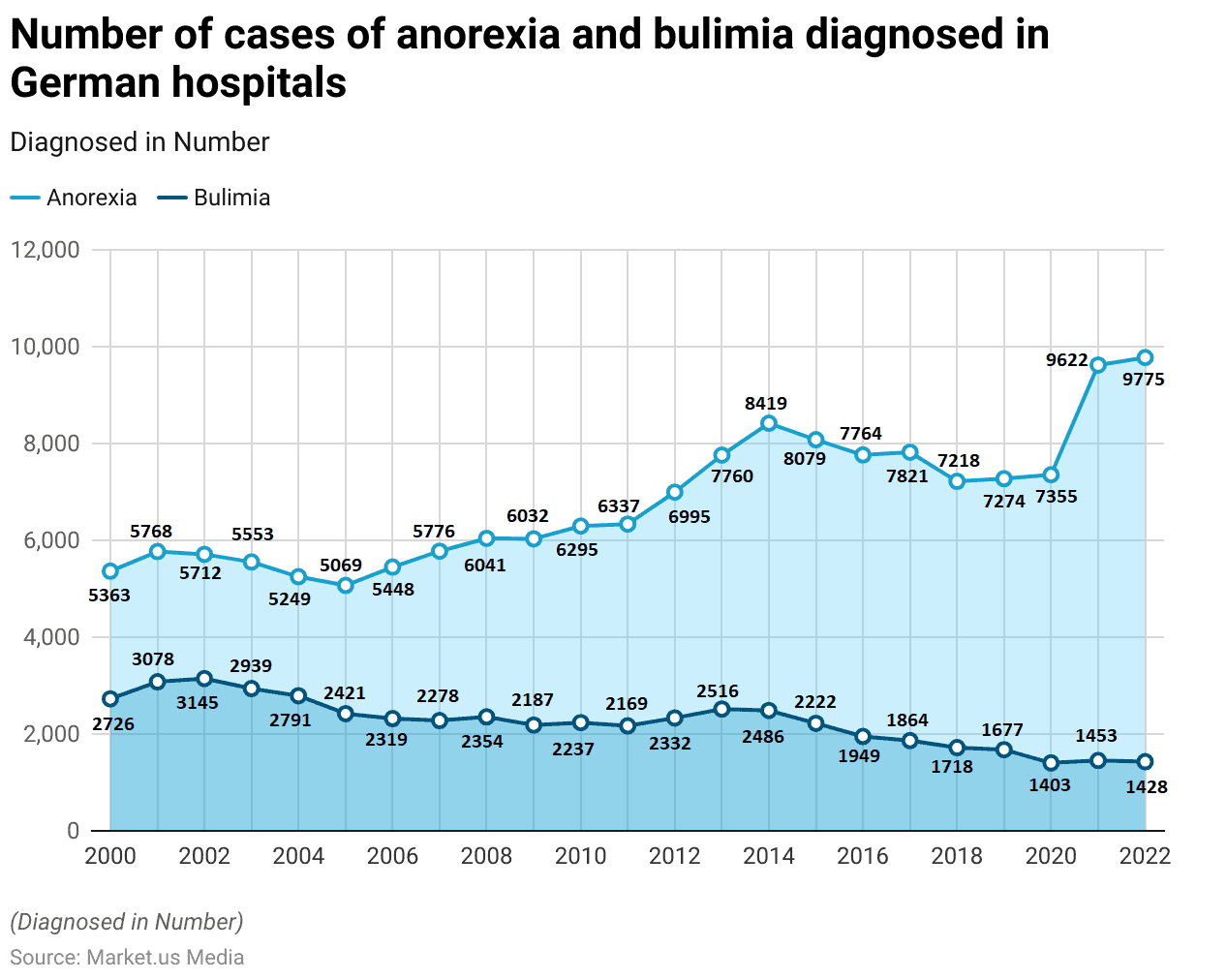
France
- The incidence of feeding and eating disorders (FEDs) such as anorexia nervosa, bulimia, and binge eating has significantly increased in France since 2019, as reported by multiple international sources.
- A significant study led by Pierre Déchelotte, who directs the nutrition department at Rouen University Hospital, analyzed 8,900 students and found that from 2009 to 2021, the prevalence of FEDs had doubled. This research was published in the journal Nutrition et Métabolisme in February 2022.
- According to the French Federation of Anorexia and Bulimia (FFAB), nearly one million individuals in France are dealing with severe FEDs, a figure considered to be an underestimate.
- Additionally, when including “other non-specific” disorders, which are eating disorders not fully meeting standard diagnostic criteria, it is estimated that 20% of women and 15% of men in France are impacted.
- Specifically, among young French women, it is estimated that between 1% and 3% suffer from anorexia, 5% from bulimia, and 11% display compulsive eating behaviors.
(Sources: Le Monde, Slate)
Belgium
- Eating disorders predominantly affect women, with 90-95% of anorexia nervosa cases occurring in females.
- Recent epidemiological studies in Belgium indicate a rise in the incidence of these disorders, particularly among adolescent girls and young women aged 15-24, with the highest prevalence around 18 years of age.
- It is believed that 5% of Belgian women have bulimia. However, this statistic is debated due to inconsistencies in the research criteria, which often focus on the 15-25 age group and exclude older women.
- This exclusion is based on the perception of bulimia, like anorexia nervosa, as primarily affecting adolescent girls.
- While there are no precise statistics for Flanders, estimates suggest about 15,000 women are affected, with around 1,000 new patients recovering each year.
- Bulimia is observed to be 3 to 5 times more common in urban areas compared to rural settings.
- Additionally, there is a growing recognition of other eating disorders, such as binge eating disorder and Anorexia Athletica, affecting both women and men.
(Source: Euro Health)
Eating Disorders
- From 2007 to 2017, the prevalence of eating disorders worldwide varied by age group, with an observable trend of increased rates over time.
- In 2007, the prevalence rate among individuals aged 30-34 was 0.47%, and this slightly increased to 0.51% by 2017. The rates for those aged 25-29 started at 0.45% in 2007, rising modestly to 0.48% in 2017.
- Similarly, the 20-24 age group saw an increase from 0.41% in 2007 to 0.45% in 2017. For teenagers aged 15-19, there was a gradual rise from 0.33% to 0.36% over the same period.
- The overall prevalence rate across all age groups began at 0.20% in 2007 and saw a slight increase to 0.21% by 2017. Among younger demographics, the prevalence for 10-14-year-olds doubled from 0.05% to 0.10% over the decade.
- For children aged 5-14, the rate remained steady at 0.05%. Notably, there were no recorded cases among individuals aged 70 and older, nor among those aged 50-69 throughout the studied years.
- This data highlights a general upward trend in the prevalence of eating disorders, particularly among younger age groups and adults up to 34 years old.
(Source: Statista)

Hospital Admissions Involving a Diagnosis of Bulimia Nervosa
- In England during the 2022/23 period, the number of hospital admissions due to bulimia nervosa varied across different age groups.
- The highest number of diagnoses was observed in the 30 to 34 age group, with 1,085 admissions, closely followed by the 25 to 29 age group, with 1,081 admissions.
- The 20 to 24 age group also saw a high number of admissions, totaling 944. Admissions were considerably lower in younger and older age brackets, with 512 admissions in the 15 to 19 age group and 63 in the 10 to 14 age group.
- For middle-aged and older adults, the numbers gradually decreased. There were 876 admissions among those aged 35 to 39, which further declined to 685 for the 40 to 44 age group and 601 for those aged 45 to 49.
- The decline continued in older age groups: 379 admissions for ages 50 to 54, 332 for ages 55 to 59, and 170 for the 60 to 64 group.
- Admissions for those aged 65 and over were significantly lower, with 90 admissions in the 65 to 69 age group, decreasing to just four admissions for those aged 90 and over.
- This distribution highlights that while bulimia nervosa is most prevalent among young adults, it affects individuals of all ages.
(Source: Statista)

Eating Disorders
- From 1990 to 2019, the percentage of the global population suffering from eating disorders exhibited a slow but consistent increase, with gender-specific prevalence rates noted.
- Initially, in 1990, 0.21% of females and 0.10% of males were affected by eating disorders.
- These rates remained stable through 2003, after which a slight increase was observed. By 2004, the prevalence among females had risen to 0.22% and for males to 0.11%.
- This incremental rise continued steadily over the years. By 2010, the prevalence for females had increased to 0.23% and for males to 0.12%.
- This trend persisted, with both genders seeing a further increase to 0.24% for females and 0.12% for males by 2016, which remained steady through 2019.
- This data highlights a gradual increase in eating disorders among both genders over nearly three decades.
(Source: Statista)

Prevalence of Eating Disorders Among Adults – By Gender
- Between 2008 and 2012, the prevalence of eating disorders among adults in the U.S. exhibited an equal distribution between males and females for specific disorders.
- Both genders had a prevalence rate of 0.10% for anorexia nervosa.
- The same rate of 0.10% applied to bulimia nervosa across both males and females.
- Furthermore, the prevalence of having one or more types of eating disorders was also consistent at 0.10% for both males and females.
- This data suggests an equal likelihood of occurrence among both genders for these conditions during this period.
(Source: Statista)

Hospital Episodes Involving a Primary Diagnosis of an Eating Disorder
- In England during the 2022/23 period, hospital episodes involving a primary diagnosis of eating disorders showed significant gender disparities across various types of disorders.
- Anorexia nervosa was diagnosed in 13,578 females compared to 837 males. Similarly, unspecified eating disorders were more prevalent among females, with 13,672 cases, as opposed to 1,253 among males.
- Bulimia nervosa also showed a higher occurrence in females, with 6,453 cases, compared to 598 in males.
- Other forms of eating disorders were recorded in 1,953 females and 848 males.
- Less common types, such as atypical anorexia nervosa, were diagnosed in 427 females and 49 males.
- Episodes of vomiting associated with other psychological disturbances were relatively fewer, with 147 cases in females and 32 in males.
- Atypical bulimia nervosa and overeating associated with other psychological disturbances were the least common, recorded in 61 females and 15 males, and 19 females and four males, respectively.
- These figures illustrate a clear predominance of eating disorder diagnoses among females compared to males across all categories.
(Source: Statista)
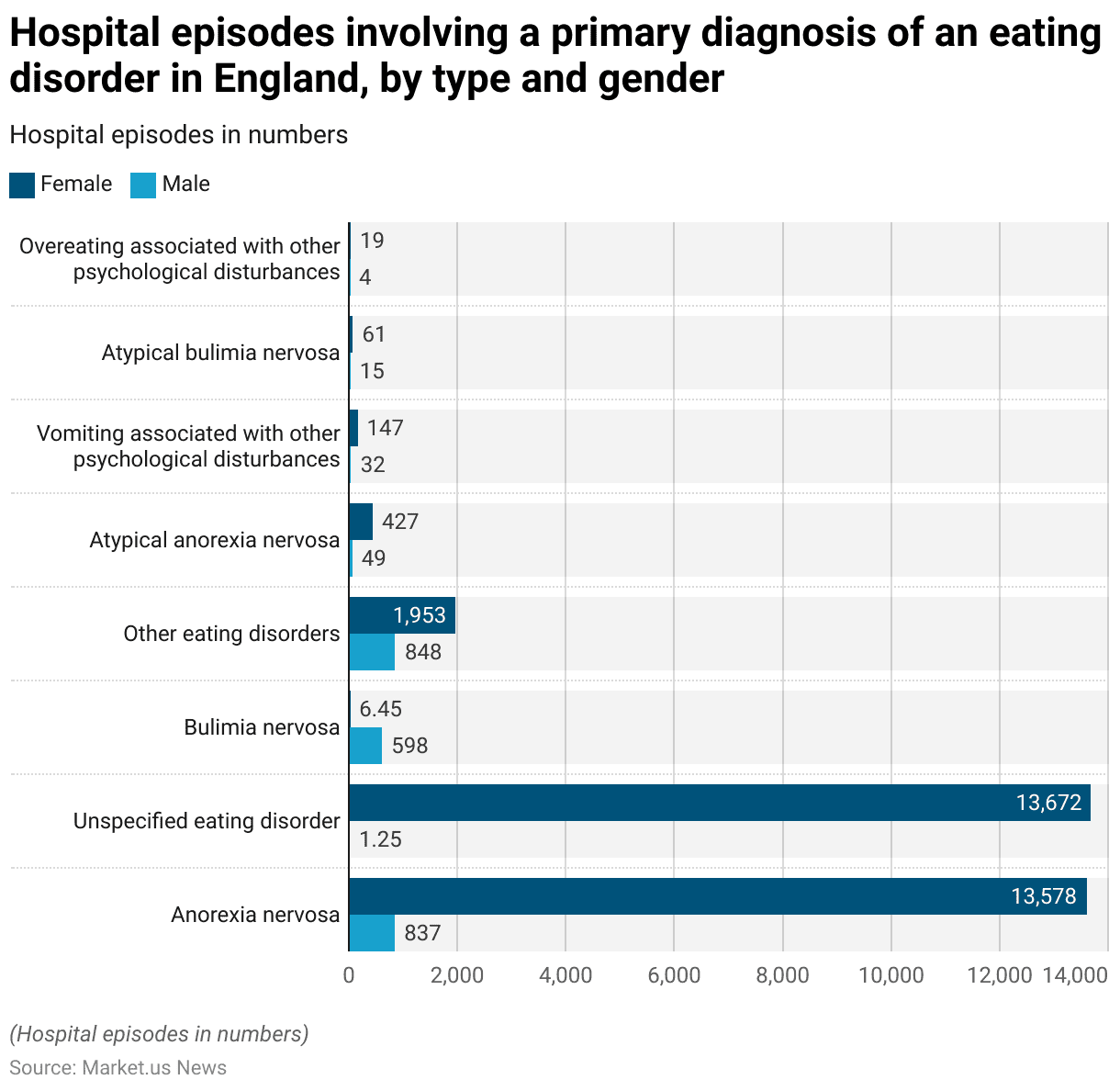
Prevalence of Children and Young People with Bulimia Nervosa – By Age and Gender
- In England in 2023, the prevalence of bulimia nervosa among children and young people displayed distinct patterns based on age and gender.
- Among 11 to 16-year-olds, the prevalence was 0.20% for boys and young men and 0.80% for girls and young women, averaging 0.50% for the group as a whole.
- In the 17 to 19-year-old age group, there were no reported cases among boys and young men, while girls and young women had a significantly higher prevalence of 3.60%, bringing the average for this group to 1.70%.
- For young adults aged 20 to 25 years, the prevalence was higher among boys and young men at 1.90%, compared to 1.60% for girls and young women, with the overall prevalence in this age group at 1.80%.
- This data highlights varying trends of bulimia nervosa prevalence across different age groups and between genders.
(Source: Statista)
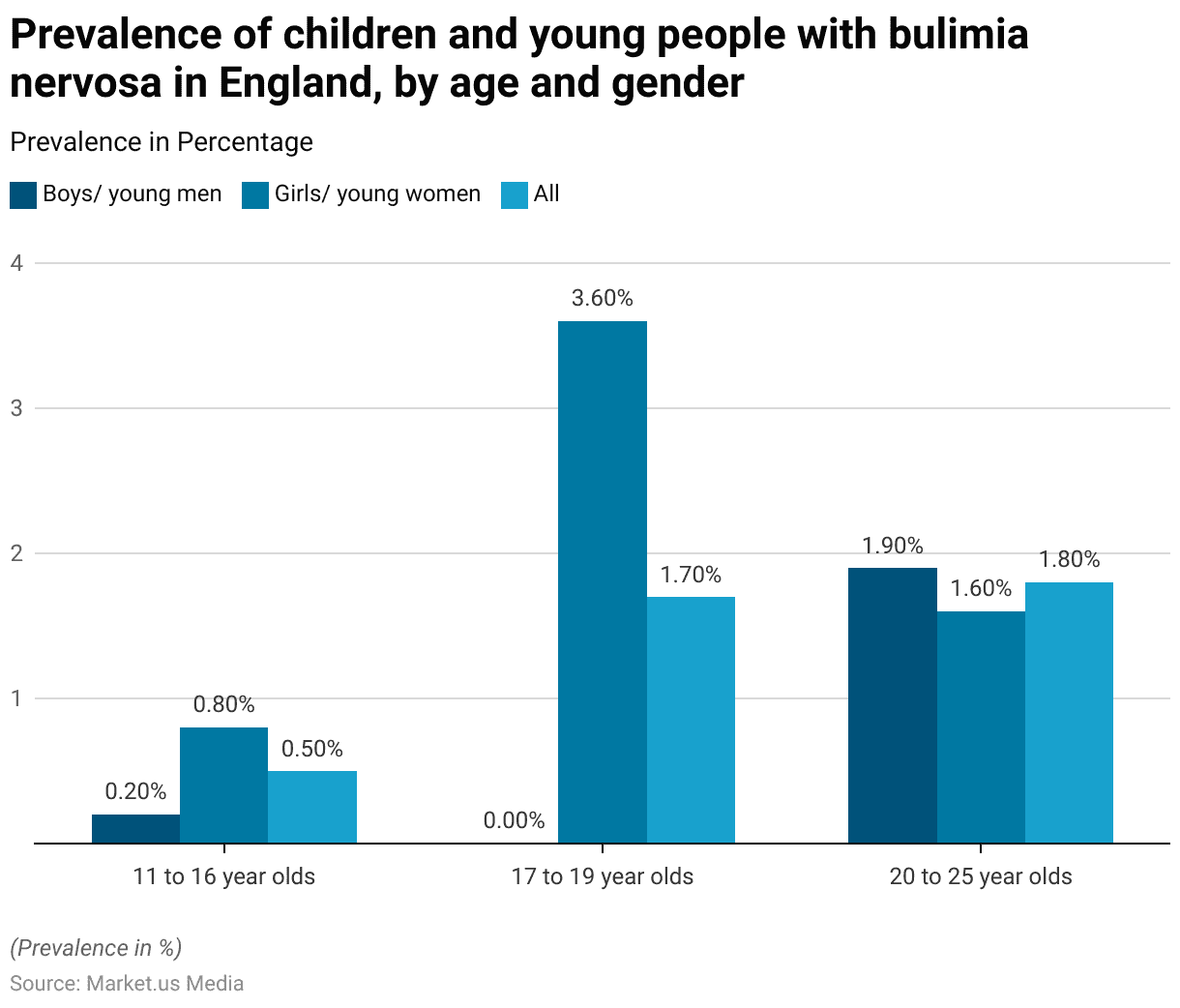
New Cases of Anorexia and Bulimia
- From 2014 to 2019, Mexico saw a notable increase in the rate of new cases of anorexia and bulimia, with distinct differences observed between genders.
- In 2014, the rate of new cases among women was 2.08 per 100,000 population, which gradually increased each year, reaching 3.5 by 2019.
- For men, the rate started at 0.8 per 100,000 in 2014 and also rose steadily, reaching 1.7 by 2019.
- The rate of increase was consistently higher for women throughout this period, with notable annual increases, particularly from 2017 onwards.
- Men, while having lower rates overall compared to women, also showed a consistent increase in the rate of new cases across these years.
- This trend highlights a growing concern regarding the prevalence of these eating disorders in both genders in Mexico.
(Source: Statista)

Eating Disorders Among Males
- The projected numbers for males in the United States diagnosed with various eating disorders from 2018 to 2030 indicate a gradual increase across all categories.
- In the 2018-19 period, an estimated 139.6 thousand males were affected by anorexia nervosa, 89 thousand by bulimia nervosa, 426.8 thousand by binge eating disorder, and 437.1 thousand by other specified feeding or eating disorders.
- By 2022-23, these figures are expected to rise slightly to 141.9 thousand for anorexia nervosa, 90 thousand for bulimia nervosa, 437.7 thousand for binge eating disorder, and 446.2 thousand for other specified disorders.
- Further projections for 2025-26 show a continued increase to 143.3 thousand for anorexia nervosa, 90.7 thousand for bulimia nervosa, 445.7 thousand for binge eating disorder, and 452.9 thousand for other specified disorders.
- By 2029-30, the numbers are expected to reach 144.8 thousand for anorexia nervosa, 92 thousand for bulimia nervosa, 457.6 thousand for binge eating disorder, and 462.8 thousand for other specified disorders.
- These trends highlight a persistent rise in the prevalence of these conditions among males in the U.S. over the stated period.
(Source: Statista)

- Between 2008 and 2012 in the U.S., the distribution of eating disorders among adults varied significantly across different ethnic groups.
- Among those identified as Not Hispanic or Latino white, there were 12,000 cases of anorexia nervosa, 41,000 cases of bulimia nervosa, and a total of 53,000 cases involving one or more eating disorders.
- For individuals categorized as Not Hispanic or Latino of other ethnicities, there were uniformly 12,000 cases each for anorexia and bulimia nervosa.
- In contrast, the Hispanic or Latino group reported significantly lower numbers, with only 4,000 cases each for anorexia nervosa and bulimia nervosa.
- This data highlights the disparities in the prevalence of eating disorders among different ethnic groups in the U.S. during this period.
(Source: Statista)
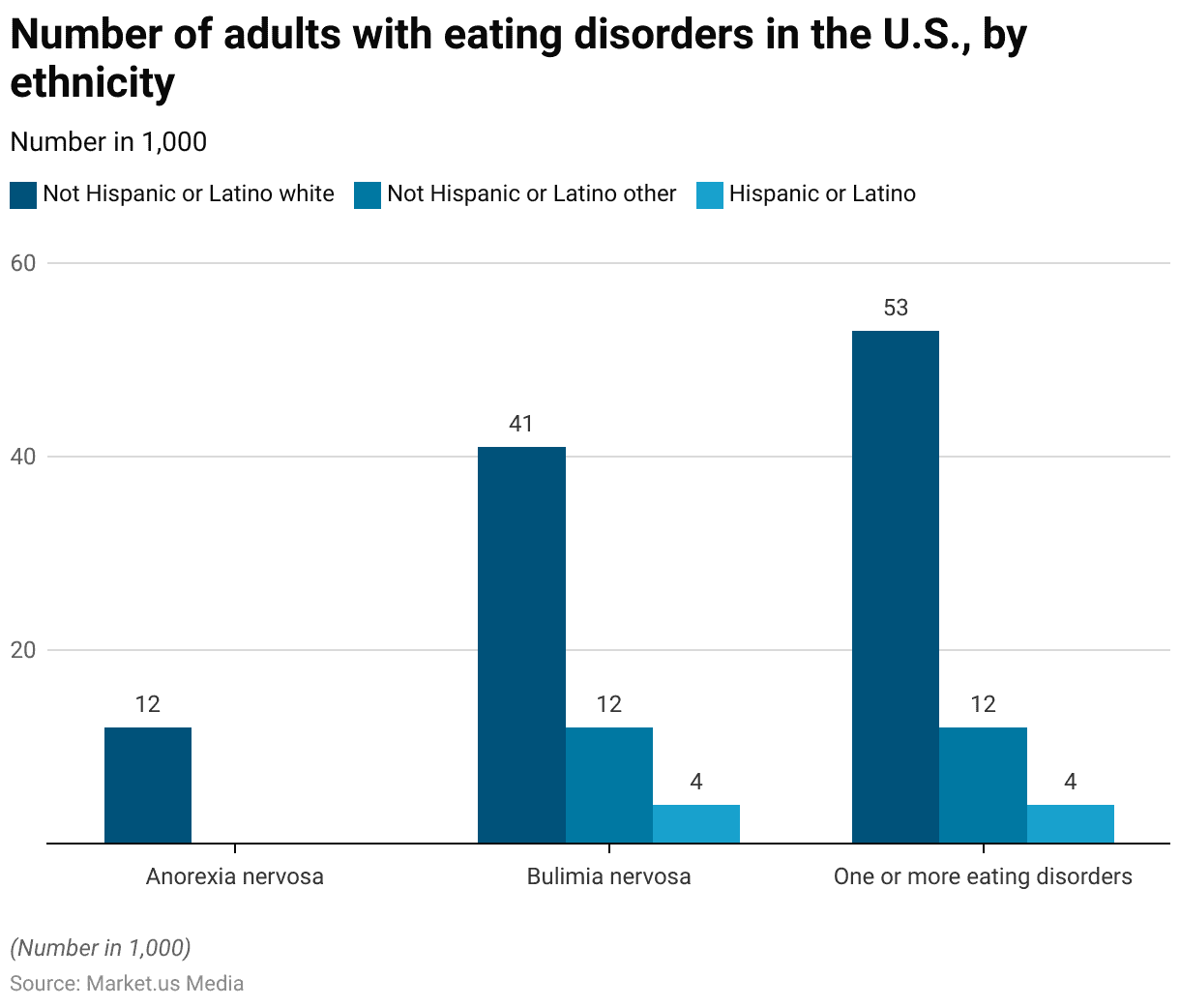
Bulimia and Related Disorders Treatment Facilities
Eating Disorder Treatment Facilities
- As of 2021, the distribution of facilities treating eating disorders in Italy varied significantly across different regions.
- Emilia Romagna had the highest number of facilities, totaling 16.
- Campania followed with ten facilities, while Lombardy had 9. Umbria provided six facilities.
- Apulia, Liguria, and Piedmont each offered five facilities for treating eating disorders.
- Friuli Venezia Giulia, Trentino South-Tyrol, Tuscany, Veneto, Sardinia, and Sicily each had 4 facilities.
- Abruzzo was equipped with 3, whereas Calabria, Marche, and Lazio each had 2.
- The regions with the fewest facilities were Basilicata and Aosta Valley, each having only one facility.
- This overview illustrates the regional disparities in the availability of treatment centers for eating disorders across Italy.
(Source: Statista)

Time Between Symptoms and Seeking Help
- In 2013, the time taken for individuals in the United Kingdom to seek help for bulimia nervosa varied widely, reflecting significant delays in addressing this eating disorder.
- A small fraction of respondents, only 1.30%, sought help immediately after recognizing symptoms. Within one month, an additional 5% of individuals had sought help.
- Those who took between 1 to 6 months to seek help accounted for 14.50% of the respondents, while 18.90% took between 6 to 12 months to do so.
- The most substantial delay was observed in those who waited more than 12 months to seek assistance, comprising 54.10% of the respondents.
- Additionally, 6.30% of the respondents were unsure about the timeframe in which they sought help.
- This data underscores the considerable delays many individuals face before seeking necessary medical intervention for bulimia nervosa in the U.K.
(Source: Statista)

Global Virtual Eating Disorder Treatment Market Size
- The market size for virtual eating disorder treatment is projected to experience significant growth from 2023 to 2033.
- Starting at $836.1 million in 2023, the market is expected to increase each year steadily.
- By 2024, it is forecasted to reach $915.5 million and, by 2025, surpass the billion-dollar mark at $1,002.5 million.
- The growth trend continues, with the market expanding to $1,097.7 million in 2026 and further to $1,202.0 million in 2027.
- By 2028, the market size is projected to grow to $1,316.2 million, and by 2029, it will increase to $1,441.3 million.
- The decade’s growth trajectory remains strong, with the market expected to reach $1,578.2 million in 2030, $1,728.1 million in 2031, and $1,892.3 million in 2032.
- By the end of the forecast period in 2033, the market for virtual eating disorder treatment is anticipated to climb to $2,072.0 million, demonstrating the increasing demand and potential for remote therapeutic options in this field.
(Source: market.us)
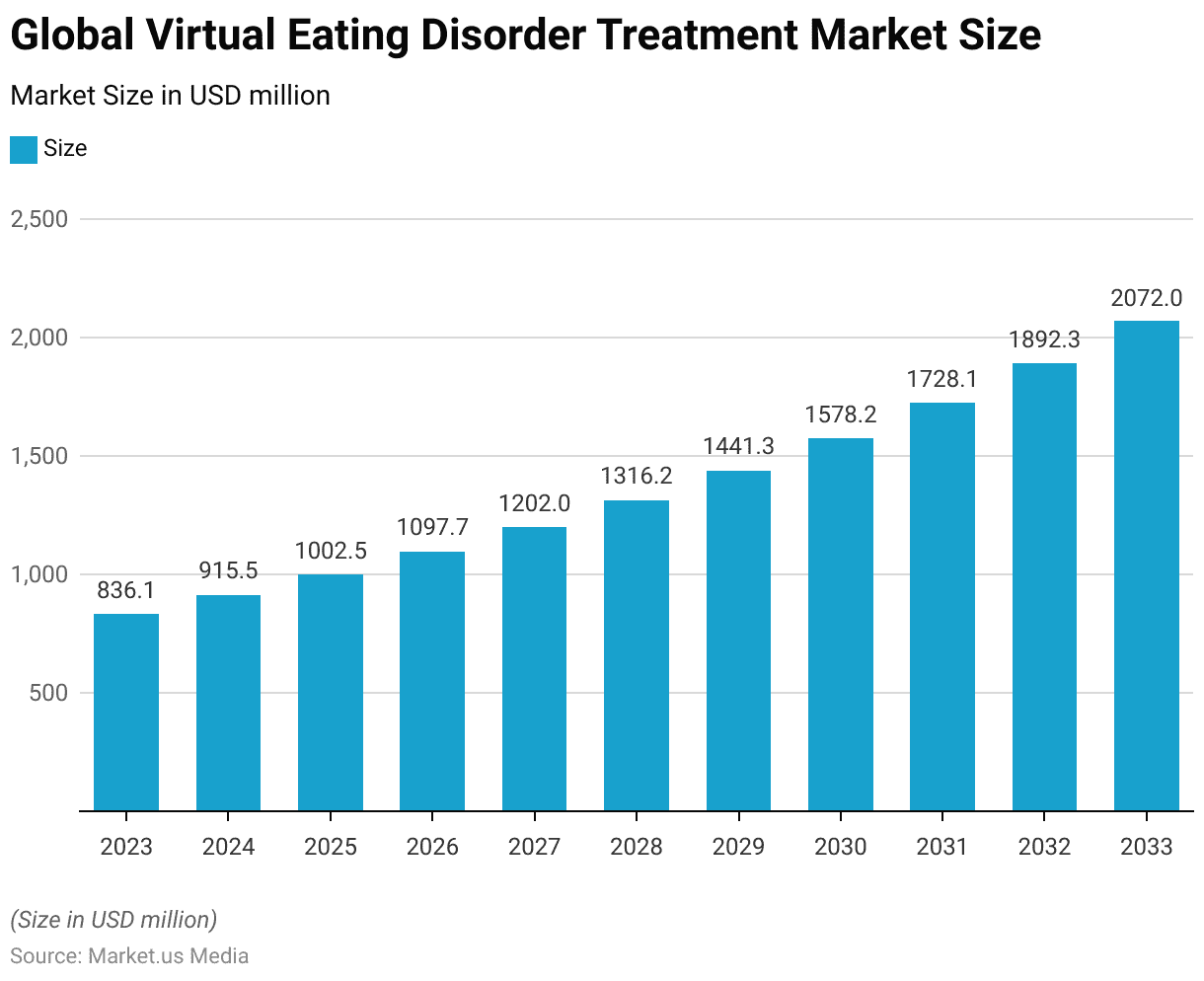
Key Funding and Investment Trends
Research Funding for Eating Disorders
- From fiscal year 2011 to 2025, the National Institutes for Health (NIH) funding for eating disorders research in the United States has shown a general upward trend.
- Starting at $27 million in 2011, the funding increased to $34 million in 2012, followed by slight decreases to $31 million in 2013 and $30 million in 2014.
- Funding levels remained relatively stable at $31 million in 2015 and dipped to $28 million in 2016.
- However, from 2017 onwards, there was a noticeable increase, with funding rising to $32 million in 2017 and further to $38 million in 2018.
- The upward trajectory continued, reaching $44 million in 2019 and $49 million in 2020.
- By 2021, the funding amounted to $51 million and stabilized at $55 million for the years 2022 through 2024.
- The forecast for 2025 indicates a rise to $59 million, reflecting ongoing commitment and increasing recognition of the importance of research in this field.
(Source: Statista)

Costs Associated with Bulimia and Related Eating Disorders
Total Costs Associated with Eating Disorders
- Between 2018 and 2019, the total costs associated with eating disorders in the United States were substantial and categorized into four main types.
- The largest cost stemmed from productivity losses, amounting to $48.63 billion, highlighting the significant economic impact due to work-related impairments and absenteeism.
- Costs related to informal care, such as caregiving provided by family and friends, were also significant, totaling $6.73 billion.
- Efficiency losses, which could include reduced productivity at work and other indirect costs, were estimated at $4.79 billion.
- Additionally, direct expenditures within the health system due to treatments and medical services reached $4.56 billion.
- These figures underscore the extensive economic burden that eating disorders place on individuals, families, and the healthcare system in the U.S.
(Source: Statista)

Financial Costs of Eating Disorders
- In 2013, the financial costs associated with eating disorders in the United Kingdom were detailed across several categories.
- The largest category, labeled “Other”, accounted for £1,233 million, encompassing various indirect costs not specified in the data.
- Expenditure on private treatment was substantial, totaling £831 million, highlighting the significant out-of-pocket expenses for individuals seeking private healthcare services.
- Additionally, travel costs related to obtaining treatment amounted to £220 million, which indicates the logistical expenses incurred by patients and their families.
- Moreover, the expenditure related to treatments provided by the National Health Service (NHS) was comparatively lower at £43 million.
- These figures collectively underscore the significant economic impact of eating disorders in the U.K., reflecting both direct and indirect costs to individuals and the healthcare system.
(Source: Statista)

Health System Cost Per Person with an Eating Disorder
- Between 2018 and 2019, the average health system costs per person for treating various eating disorders in the United States varied significantly based on the type of disorder.
- Anorexia nervosa had the highest cost at $2,615 per individual, reflecting the intensive care and long-term treatment often required for this condition.
- Bulimia nervosa followed with a considerably lower cost of $1,335 per person, indicating potentially less complex or shorter treatment protocols.
- Binge eating disorder and other specified feeding and eating disorders had the lowest costs, at $590 and $603 per person, respectively.
- These figures highlight the varying financial burdens placed on the health system by different types of eating disorders, with anorexia nervosa being the costliest on average per patient.
(Source: Statista)

Programs and Initiatives to Combat Bulimia
- Efforts to combat bulimia involve a variety of programs and initiatives from the public and private sectors, focusing on awareness, prevention, and early intervention.
- The Eating Disorders Coalition, for instance, supports legislation like the Anna Westin Legacy Act to promote early intervention and better training for healthcare professionals in recognizing eating disorders.
- Moreover, the U.S. Department of Health and Human Services has allocated significant funding towards community-based interventions specifically targeting at-risk populations, such as teen girls, during the pandemic.
- Additionally, comprehensive strategies like Australia’s National Eating Disorders Strategy 2023-2033 outline a systemic approach to improve care. Aiming for an integrated and evidence-based system of support across health services.
- This strategy emphasizes prevention, early intervention, and ongoing recovery support tailored to diverse groups. Including those with lived experience and high-risk populations.
- Prevention programs, particularly those targeting high-risk groups such as adolescents. Often incorporate elements such as cognitive dissonance and media literacy to mitigate the risk factors associated with eating disorders. These programs have been shown to reduce symptomatology for up to three years post-intervention.
- Similarly, the Body Project provides a peer-led intervention that challenges societal beauty norms, which has been effective in fostering positive body image among young women. Thereby reducing the likelihood of developing eating disorders.
- These initiatives collectively represent a proactive approach to managing and potentially reducing the incidence of bulimia through education, legislative action, and strategic health service planning.
(Sources: NEDC, Health & Aged Care, Eating Disorders Coalition, BioMed Central, National Eating Disorders Association)
Regulations for Bulimia Treatment
- Regulations and policies regarding bulimia treatment vary significantly by country, reflecting diverse approaches to healthcare provision and public health strategies.
- In the United States, state-level legislation often targets the broader context of eating disorders, incorporating measures such as fines for the sale of harmful diet pills and incentives for businesses that avoid using altered images in advertising.
- For instance, Massachusetts has introduced bills like H.4783 to restrict diet pill sales to minors and incentivize the use of unaltered images.
- At the federal level, the U.S. policy has historically focused more on educational and treatment initiatives rather than direct regulation. The 21st Century Cures Act is a notable federal initiative, incorporating key aspects of the Anna Westin Act to enhance health insurance coverage and increase educational resources about eating disorders.
- In contrast, the U.K. has established regulations via the National Health Service (NHS) that focus on comprehensive treatment pathways for bulimia, emphasizing the importance of psychological interventions alongside medical treatment.
- The approach is somewhat similar in Canada, where guidelines emphasize community-based treatment and recovery programs supported by healthcare policy that encourages early intervention and treatment continuity.
- These regulations are crucial for shaping public health responses and ensuring the availability of resources and support for individuals affected by bulimia. Each country’s specific policies reflect its healthcare infrastructure and cultural attitudes towards mental health and eating disorders.
(Source: Policy Perspectives)
Recent Developments
Acquisitions and Mergers:
- Acadia Healthcare acquired Center for Hope of the Sierras: In 2023, Acadia Healthcare, a leading provider of behavioral healthcare services, acquired Center for Hope of the Sierras, a specialized eating disorder treatment facility. This acquisition allows Acadia to expand its offerings for treating eating disorders like bulimia in the U.S.
- Monte Nido & Affiliates merges with Walden Behavioral Care: In 2024, Monte Nido & Affiliates, a provider of treatment for eating disorders, announced a merger with Walden Behavioral Care. The merger aims to provide broader access to bulimia treatment services across the U.S., integrating their resources to treat more patients in specialized settings.
New Treatment Programs:
- The Emily Program launches virtual bulimia treatment services: In 2023, The Emily Program, a national leader in eating disorder treatment, launched virtual treatment services specifically for bulimia. These online programs are designed to provide more accessible treatment options for individuals who may not be able to attend in-person sessions.
- BetterHelp introduces counseling for bulimia: In 2024, BetterHelp, an online counseling service, expanded its offerings to include specialized therapy for bulimia. The platform now connects individuals with licensed therapists who focus on treating eating disorders, making mental health care more accessible to those struggling with bulimia.
Funding:
- Equip raises $58 million for digital eating disorder treatment: In 2023, Equip, a virtual eating disorder treatment provider, raised $58 million in a Series B funding round to expand its services. The company focuses on providing treatment for conditions such as bulimia through family-based therapy and aims to expand its reach across the U.S.
- Within Health secures $20 million for tech-driven bulimia treatment: In early 2024, Within Health, a digital health company focused on eating disorders secured $20 million in funding. The company is developing personalized treatment plans for bulimia using telemedicine and digital tools to improve outcomes for patients.
Technological Advancements:
- AI-driven therapy tools: Artificial intelligence is being integrated into therapy tools to provide personalized treatment for eating disorders like bulimia. By 2025, over 30% of digital mental health platforms are expected to incorporate AI tools to help tailor treatment plans and provide real-time support to users.
- Telehealth expansion for eating disorders: Telehealth has seen significant growth in treating eating disorders, including bulimia. By 2026, 50% of eating disorder treatment is expected to be delivered through telehealth platforms, enabling patients to access care remotely and increasing treatment availability.
Conclusion
Bulimic Statistics – Bulimia nervosa is a serious eating disorder marked by binge eating followed by compensatory behaviors like self-induced vomiting.
It primarily affects adolescents and young adults and poses significant health risks, including electrolyte imbalances and dental damage.
Treatment typically involves a combination of cognitive-behavioral therapy, nutritional counseling, and sometimes medications.
Addressing bulimia effectively requires early intervention and long-term commitment to recovery, with awareness and education being crucial for early detection and reducing stigma. With the right support and treatment, individuals can recover and lead healthy lives.
FAQs
Bulimia nervosa is an eating disorder characterized by periods of binge eating followed by purging behaviors to prevent weight gain, such as vomiting, excessive exercise, or the use of laxatives.
The exact cause of bulimia is unknown, but it is believed to result from a combination of genetic, biological, environmental, and psychological factors. Societal pressures and an obsession with body image can also contribute.
Symptoms include recurrent episodes of binge eating, feeling a lack of control during binges, self-induced vomiting, misuse of laxatives, excessive exercise, fasting, preoccupation with body weight and shape, and extreme concern with body weight and shape.
Diagnosis typically involves a comprehensive evaluation, including a medical assessment and discussion of eating habits. Mental health professionals may use specific diagnostic criteria from the DSM-5 to identify the disorder.
Complications can be severe and include electrolyte imbalances, gastrointestinal problems, dental issues, heart difficulties, and mental health disorders such as anxiety and depression.
Treatment often involves a combination of psychotherapy, nutritional education, and medication. Cognitive-behavioral therapy (CBT) is commonly used to help change unhealthy eating behaviors and thoughts. Antidepressants might also be prescribed.
While bulimia cannot always be prevented, educating young people about the risks of eating disorders and promoting a healthy body image can help reduce its onset.
Discuss your needs with our analyst
Please share your requirements with more details so our analyst can check if they can solve your problem(s)



